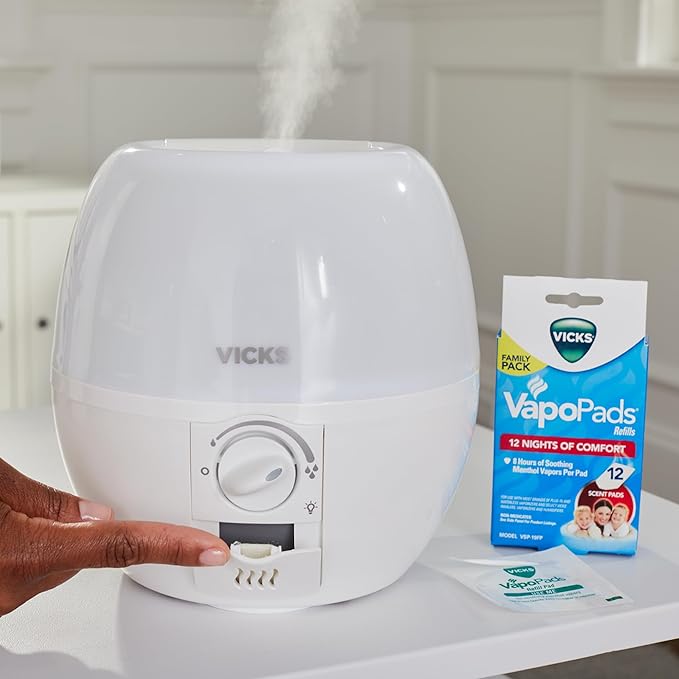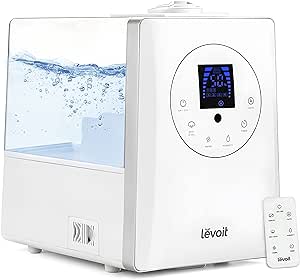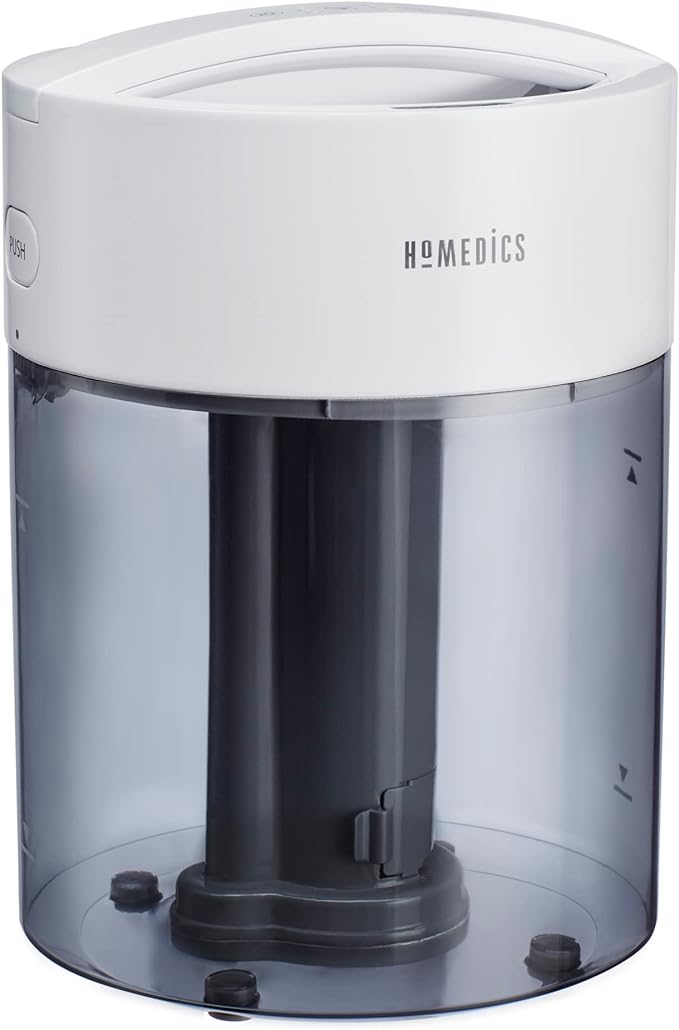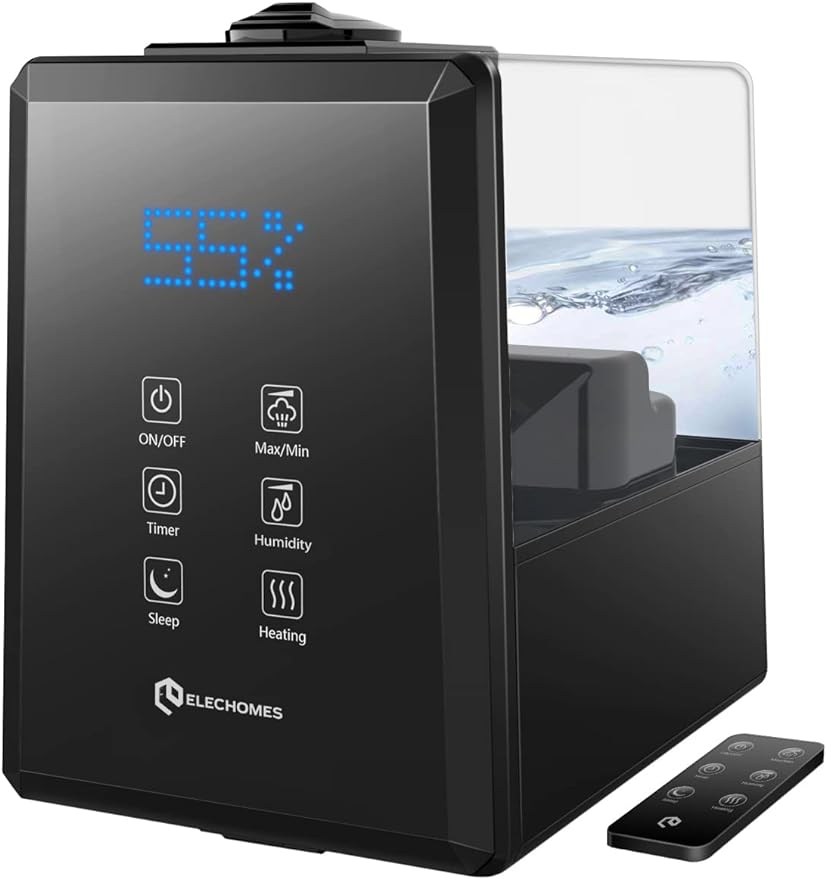
The 7 Best Self-Cleaning Humidifiers To Buy In 2023

Humidifiers are essential for maintaining comfortable humidity levels in your home, especially during dry seasons or in climates with low moisture. However, cleaning traditional humidifiers can be a tedious and time-consuming task. Enter self-cleaning humidifiers, a convenient solution designed to simplify maintenance and provide consistent moisture without the hassle.
We’ve curated a list of the top 7 self-cleaning humidifiers on the market, considering factors like effectiveness, ease of maintenance, capacity, and additional features to help you make an informed decision.
Tips for Choosing a Self-Cleaning Humidifier
When selecting a self-cleaning humidifier, several factors can help you make the best choice for your needs and preferences:
1. Cleaning Mechanism
Look for specifics on the cleaning mechanism. UV technology, ultrasonic vibrations, or specific filters can indicate how effectively the unit keeps the water clean. UV technology is known for its ability to kill bacteria and germs, while certain filters prevent mineral build-up.
2. Room Size and Coverage
Consider the size of the room or area you want to humidify. Check the coverage area the humidifier can handle to ensure it’s suitable for your space. Choosing a humidifier with an appropriate coverage capacity prevents under or over-humidification.
3. Capacity and Runtime
The water tank capacity determines how long the humidifier can run before needing a refill. Larger capacities are beneficial for larger spaces or for longer periods of use without constant refills.
4. Additional Features
Explore additional features such as automatic shut-off, adjustable mist levels, humidistats, timers, and remote controls. These features enhance convenience and customization options for your desired comfort level.
5. Ease of Maintenance
Even though it’s a self-cleaning unit, assess how easy it is to access and clean components when necessary. Units with removable parts or accessible cleaning modes can simplify regular maintenance.
6. Noise Level
Consider the noise level of the humidifier, especially if you plan to use it in a bedroom or office space. Some humidifiers operate quietly, while others might produce more noticeable noise.
7. Price and Warranty
Compare prices among different models while considering their features and capabilities. Additionally, check for warranty coverage to ensure support and assistance if any issues arise.
8. User Reviews and Reputation
Research user reviews and the reputation of the brand or specific model. Insights from other consumers can provide valuable information about performance, durability, and overall satisfaction.
9. Water Source and Filters
Some humidifiers might require specific water types. Consider whether you have easy access to the recommended water source. Also, check if the unit requires filter replacements and their availability.
10. Follow Manufacturer’s Instructions
Lastly, follow the manufacturer’s guidelines for proper usage, maintenance, and cleaning. Even though the unit may have self-cleaning features, adhering to recommended practices ensures optimal performance and longevity.
By considering these aspects, you can narrow down your options and find a self-cleaning humidifier that perfectly suits your needs while maintaining a healthy and comfortable indoor environment.
Tips for Cleaning a Self-Cleaning Humidifier
While self-cleaning humidifiers simplify maintenance, periodic cleaning is still essential to ensure optimal performance and hygiene. Follow these steps for effective cleaning:
1. Read the Manual
Refer to the manufacturer’s instructions for specific cleaning guidelines. Each model may have unique components or cleaning methods.
2. Regular Maintenance
Even though it’s self-cleaning, perform routine checks to ensure proper functioning. Clean visible parts like the water tank and surfaces regularly.
3. Empty and Refill with Fresh Water Daily
To prevent bacterial growth, empty the water tank daily and refill it with fresh, clean water. Stagnant water can harbor microbes even in self-cleaning units.
4. Clean Removable Parts
If the humidifier has removable parts, such as filters or trays, clean them according to the manufacturer’s instructions. Replace filters as recommended.
5. Descale When Necessary
If mineral deposits accumulate, use a descaling solution recommended by the manufacturer to remove scale build-up. Follow the instructions carefully.
6. Use Distilled Water
Using distilled or demineralized water reduces mineral build-up and extends the time between cleanings. It also prevents white dust from dispersing into the air.
7. Inspect and Clean Sensors
If your humidifier has sensors or probes, check and clean them periodically to ensure accurate readings and proper functionality.
8. Avoid Harsh Cleaning Agents
Avoid using harsh chemicals or detergents, as they can damage the unit or leave residues that affect air quality. Stick to recommended cleaning solutions.
9. Let Components Dry Thoroughly
After cleaning, ensure all components are completely dry before reassembling the humidifier. Moisture can promote mold or bacteria growth.
10. Regular Check-ups
Perform occasional deep cleanings, especially if you notice a decrease in mist output or detect any unusual odors. This maintains optimal performance.
11. Maintenance Mode
If your unit has a maintenance or cleaning mode, utilize it as recommended by the manufacturer to ensure thorough cleaning.
By following these cleaning tips and maintaining a regular cleaning schedule, you can ensure that your self-cleaning humidifier operates efficiently, providing clean and comfortable air in your home or workspace.
7 Best Self-Cleaning Humidifiers
1. Dyson Pure Humidify+Cool

- Capacity: 1.8 gallons
- Coverage: Up to 400 sq. ft.
- Key Feature: Ultraviolet Cleanse technology for bacteria removal
- Price: $599.99
The Dyson Pure Humidify+Cool stands out for its efficient humidifying and air purifying capabilities. Its self-cleaning system uses UV technology to kill 99.9% of bacteria in the water, ensuring clean mist output. With its sleek design and multifunctionality, this unit offers excellent value.
2. Honeywell HCM350W Germ-Free Cool Mist Humidifier

| Specifications | Details |
|---|---|
| Capacity | 1 gallon |
| Coverage | Up to 500 sq. ft. |
| Key Feature | Protec Cleaning |
| Price | $64.99 |
Honeywell’s HCM350W excels in germ-free humidification. The Protec Cleaning feature prevents mold and bacteria growth, and the unit’s affordable price makes it an attractive choice for smaller spaces.
3. Levoit Hybrid Ultrasonic Humidifier LV600HH

| Specifications | Details |
|---|---|
| Capacity | 1.5 gallons |
| Coverage | Up to 753 sq. ft. |
| Key Feature | Auto Mode & Remote |
| Price | $89.99 |
The LV600HH from Levoit combines ultrasonic technology with a self-cleaning mode, ensuring a hygienic mist. The added convenience of a remote control and auto mode makes it a user-friendly option for larger rooms.
4. TaoTronics TT-AH025B Cool Mist Humidifier

- Capacity: 4 liters
- Coverage: Up to 322 sq. ft.
- Key Feature: Microporous Cartridge
- Price: $49.99
TaoTronics’ TT-AH025B utilizes a microporous cartridge to filter out impurities, maintaining a clean mist. Its compact design and quiet operation make it ideal for bedrooms or smaller living spaces.
5. BONECO U350 Ultrasonic Humidifier

| Specifications | Details |
|---|---|
| Capacity | 1.5 gallons |
| Coverage | Up to 650 sq. ft. |
| Key Feature | Hydro Cell & EZCal |
| Price | $149.99 |
The BONECO U350 employs Hydro Cell technology to keep the water fresh, minimizing mineral build-up. The addition of EZCal ensures easy maintenance, making it a reliable option for medium-sized rooms.
6. Elechomes UC5501 Ultrasonic Humidifier

- Capacity: 6 liters
- Coverage: Up to 750 sq. ft.
- Key Feature: Intelligent Humidity Control
- Price: $89.99
Elechomes’ UC5501 impresses with its high capacity and intelligent humidity control. The self-cleaning function coupled with adjustable mist levels caters to varying preferences, perfect for larger living spaces.
7. Vicks V3900 Germ-Free Cool Mist Humidifier

| Specifications | Details |
|---|---|
| Capacity | 1 gallon |
| Coverage | Up to 400 sq. ft. |
| Key Feature | UV Technology |
| Price | $59.99 |
Vicks’ V3900 features UV technology to kill germs in the water, ensuring a clean mist output. Its affordability and reliability make it a popular choice for smaller areas.
Important Note: While self-cleaning humidifiers simplify maintenance, regular cleaning and proper use of distilled water are still recommended to maintain optimal performance and prolong the unit’s lifespan.
When choosing a self-cleaning humidifier, consider the room size, additional features, and your budget. Each of these top 7 options offers a unique set of features catering to various needs, ensuring a healthier and more comfortable indoor environment.
Frequently Asked Questions about Self-Cleaning Humidifiers
Here are some common queries people have about self-cleaning humidifiers:
1. What makes a humidifier “self-cleaning”?
Answer: Self-cleaning humidifiers typically employ technologies such as UV light, ultrasonic vibrations, or specialized filters to inhibit the growth of mold, bacteria, and mineral deposits within the unit. These mechanisms help maintain cleaner water and prevent the need for frequent manual cleanings.
2. Are self-cleaning humidifiers completely maintenance-free?
Answer: While self-cleaning humidifiers reduce the frequency of manual cleanings, they still require regular maintenance. Daily water changes, occasional deep cleanings, and filter replacements (if applicable) are necessary to ensure optimal performance.
3. Can I use regular tap water in a self-cleaning humidifier?
Answer: It’s recommended to use distilled or demineralized water to minimize mineral deposits in the unit. Tap water contains minerals that can accumulate and affect the humidifier’s efficiency over time.
4. How often should I clean a self-cleaning humidifier?
Answer: Despite their self-cleaning features, regular maintenance is crucial. Daily water changes, weekly surface cleanings, and periodic deep cleanings are recommended to prevent bacteria growth and maintain the unit’s effectiveness.
5. Do self-cleaning humidifiers eliminate white dust?
Answer: Using distilled water reduces the formation of white dust caused by mineral deposits. However, self-cleaning humidifiers may not entirely eliminate this issue, especially if tap water is used.
6. Are self-cleaning humidifiers quieter than regular ones?
Answer: The cleaning mechanism itself does not significantly impact the noise level. The noise level depends more on the type of humidification (e.g., ultrasonic or evaporative) rather than the self-cleaning feature.
7. How long do the self-cleaning mechanisms last?
Answer: The longevity of self-cleaning mechanisms varies among models and depends on usage. Regular maintenance and following the manufacturer’s guidelines can help prolong their effectiveness.
8. Can I still manually clean a self-cleaning humidifier?
Answer: Yes, performing manual cleanings occasionally is recommended, especially for visible parts and components that might not be reached by the self-cleaning mechanism.
9. Are self-cleaning humidifiers more expensive?
Answer: Self-cleaning humidifiers might have a higher initial cost compared to basic models, but they can save money in the long run by reducing the need for frequent filter replacements or extensive manual cleanings.
10. Can self-cleaning humidifiers help with allergies or respiratory issues?
Answer: By maintaining cleaner water and reducing the growth of mold and bacteria, self-cleaning humidifiers can contribute to improved indoor air quality, potentially benefiting individuals with allergies or respiratory conditions. However, consult a healthcare professional for specific advice.
These FAQs aim to address common concerns and provide insights into the functionality and maintenance of self-cleaning humidifiers.









